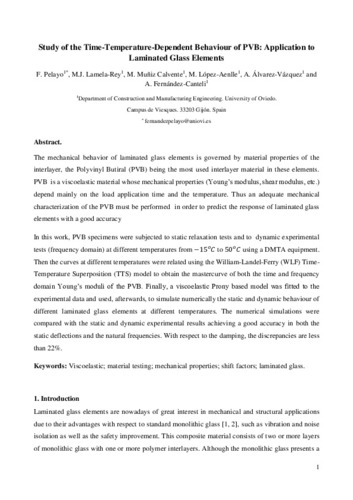Study of the Time-Temperature-Dependent behaviour of PVB: application to laminated glass elements
Fecha de publicación:
Editorial:
Elsevier
Versión del editor:
Citación:
Descripción física:
Resumen:
The mechanical behavior of laminated glass elements is governed by material properties of the interlayer, the Polyvinyl Butiral (PVB) being the most used interlayer material in these elements. PVB is a viscoelastic material whose mechanical properties (Young’s modulus, shear modulus, etc.) depend mainly on the load application time and the temperature. Thus an adequate mechanical characterization of the PVB must be performed in order to predict the response of laminated glass elements with a good accuracy In this work, PVB specimens were subjected to static relaxation tests and to dynamic experimental tests (frequency domain) at different temperatures from -〖15〗^o C to 〖50〗^o C using a DMTA equipment. Then the curves at different temperatures were related using the William-Landel-Ferry (WLF) Time-Temperature Superposition (TTS) model to obtain the mastercurve of both the time and frequency domain Young’s moduli of the PVB. Finally, a viscoelastic Prony based model was fitted to the experimental data and used, afterwards, to simulate numerically the static and dynamic behaviour of different laminated glass elements at different temperatures. The numerical simulations were compared with the static and dynamic experimental results achieving a good accuracy in both the static deflections and the natural frequencies. With respect to the damping, the discrepancies are less than 22%.
The mechanical behavior of laminated glass elements is governed by material properties of the interlayer, the Polyvinyl Butiral (PVB) being the most used interlayer material in these elements. PVB is a viscoelastic material whose mechanical properties (Young’s modulus, shear modulus, etc.) depend mainly on the load application time and the temperature. Thus an adequate mechanical characterization of the PVB must be performed in order to predict the response of laminated glass elements with a good accuracy In this work, PVB specimens were subjected to static relaxation tests and to dynamic experimental tests (frequency domain) at different temperatures from -〖15〗^o C to 〖50〗^o C using a DMTA equipment. Then the curves at different temperatures were related using the William-Landel-Ferry (WLF) Time-Temperature Superposition (TTS) model to obtain the mastercurve of both the time and frequency domain Young’s moduli of the PVB. Finally, a viscoelastic Prony based model was fitted to the experimental data and used, afterwards, to simulate numerically the static and dynamic behaviour of different laminated glass elements at different temperatures. The numerical simulations were compared with the static and dynamic experimental results achieving a good accuracy in both the static deflections and the natural frequencies. With respect to the damping, the discrepancies are less than 22%.
ISSN:
Patrocinado por:
Asturian Regional Research through the Severo Ochoa Pre-doctoral Grants,BIA2011-28959, BIA2014-53774-R and DPI2016-80389-C2-2-R
Colecciones
- Artículos [37556]
- Construcción e Ingeniería de Fabricación [508]
- Investigaciones y Documentos OpenAIRE [8424]
Ficheros en el ítem





